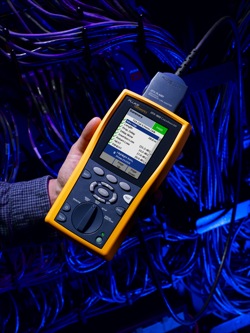
BY RON GROULX
As network testing requirements have grown in scope and complexity so, too, have the number and type of cable testers. Today, cable test tools come in all shapes and sizes and, while every tester has its uses, not all of them will meet the required standards or certification warranty requirements for specific applications.
 When faced with so many choices, it can be a challenge to decide what’s
When faced with so many choices, it can be a challenge to decide what’s
right for your needs, so I’ve put together a test tool primer that
provides some basic guidelines and recommendations.
It all begins
with understanding the three basic categories of cable test tools.
These are:
•
Qualification testers
• Certification testers
In many
cases, features and functions may overlap between categories. However,
each type of tester answers specific questions for the technician.
By
way of example, a certification
tester will tell you whether an installed cabling link complies with
TIA/ISO standards (Telecommunications Industry Association/International
Organization for Standardization), while a qualification tester will specify whether the link
supports the desired network speed or technology. for their part, verification testers are specifically
designed to identify proper cable connections.
Verification testing
Verification
testers are ubiquitous, simple-to-use, low-cost tools that are often the
first line of attack in finding cabling problems. They are typically
used by a technician whose job is to pull and terminate cables, or to
perform basic moves, adds and changes (MACs).
In addition to
performing basic continuity functions (i.e. wiremap, toning), some
verification testers offer additional features, such as a time domain
reflectometer (TDR) to determine the length of the cabling link or the
distance to a break or short circuit in the link-under-test. They may
also check coax connections and support continuity of fiber optics
links, as well as detect and report that the cable-under-test is
connected to an active device, such as a hub or switch. A visual fault
locator (VFL) could also be considered a verification tool, since it
verifies contiguous fiber connections and polarity.
Qualification testing
Qualification
tools are relatively new to the world of cable testing, but are
essential in helping technicians who need to upgrade a network to higher
speeds and/or troubleshoot connectivity problems. While more powerful
than verification tools, they do not perform the battery of tests
required to be a certification tool.
A qualification tool will
tell you what network speeds and technologies (i.e. VoIP,
10/100/1000Base-T) can be successfully deployed on a given link, and
provide valuable information when troubleshooting crosstalk problems
[interference] related to poor cabling installation practices.
{mospagebreak}
Certification testing
Certification
testers are the most sophisticated of the three categories of test
tools and perform the most powerful functions. They are designed to
provide advanced diagnostics when a cabling link fails a performance
test. They are the tool of choice for network owners who want to check
third-party installations, or to show that a link-under-test is failing
Cat 5e, Cat 6 or Cat 6A performance requirements.
These testers
are invaluable when a technician needs to confirm network performance in
the event of a discrepancy or debate. In addition, certification to
standards is a prerequisite for warranty purposes from structured
cabling manufacturers. A certification test is the only way to prove to
the network owner that all cabling has been installed correctly in
accordance with TIA and ISO standards.
Certification testers
provide Pass or Fail information based on industry standard limits,
while providing detailed results based on measurements across predefined
frequency ranges. In addition to testing channel configuration (a job
that is also performed by qualification and verification testers),
certification tools also test the permanent link commonly installed by
commercial contractors. Many tools also support optical fiber test
options, advanced graphical diagnostics and reporting capabilities.
The
features and functions of these devices can vary considerably. Some
certification testers can pinpoint the location and nature of a problem,
and provide instructions for inspection and corrective action, saving
hours of unproductive probing, guesswork, unnecessary component
replacement or re-terminating of connections.
Do your homework
Knowing the basics
about each type of test tool is a good place to start. That said, it’s
also important to review all the features and functions of any given
tool to determine whether the product you choose is right for the job.
Ron Groulx is product specialist for FLUKE NETWORKS CANADA. Having
worked in the industry for almost 10 years and a graduate in computer
science, he is knowledgeable in all aspects of networking, from cabling
infrastructure to network monitoring and troubleshooting. For more
information on cable testers, take advantage of Fluke’s application
notes online at www.flukenetworks.com. Ron can be reached at
ron.groulx@fluke.com
Print this page